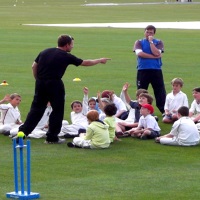Here's the Most Powerful Tool in Your Coaching Toolbox
 Coach and PitchVision Academy Columnist Sam Lavery looks at the power of words to help cricketers grow.
Coach and PitchVision Academy Columnist Sam Lavery looks at the power of words to help cricketers grow.
Can the way you speak turn players into positive "doers"?
Attention to detail in the language we use as coaches is important as we strive for perfection. Not only is what we deliver vital, but also, how we choose to deliver it.
Simply, language will help cricketers achieve what you - and they - would like.
Here's a simple example.
Your star fast bowler is having a nightmare. Instead of taking wickets he is repeatedly firing the ball down the leg side. At break in play you get a moment to speak to him.
What do you say?
"Don't bowl any more leg side wides."
Or how about:
"Keep focusing on that off stump channel."
Simply by saying the same thing in two different ways, you can create a different mindset and outcome.
This applies to all cricket skills. Another example is in nets.
One of your batsmen unsuccessfully takes an almighty swing at the spinner. It's ugly, it's out of context, it reveals a lack of focus. it's so wrong you don't know where to start. So you say,
"Come on, stop slogging."
We hear it all the time don’t we?
I know I have said it. I'm sure you have too. Ask yourself though, is it the right choice of words?
You could rephrase your advice,
"Try and be more selective next time. Get a little closer to the ball and keep your eyes on it through to contact to hold your shape next time you get a chance to take him on."
You're trying to achieve a positive outcome: Better shot selection, more accurate bowling, the list goes on.
So, use words that encompass what you want to achieve, not what you don't want happen.
I'm sure you're aware of the simple exercise where someone says, "don’t think of a pink elephant". What do you do? Of course, the first thing you think of is pink elephants.
Modern psychologists call this visualisation. We know this has influence success.
"Don't bowl any more leg side wides", immediately conjures up the image of the ball slipping past the batters pads and beyond leg stump.
"Keep focusing on that off stump channel", creates the more positive image of what we want to achieve.
Both sentences are alluding to the same principle, but one is likely to create imagery that is much more positive than the other.
How can you check yourself?
Try recording one of your sessions and assess your language. It's tough to watch yourself, but it's worthwhile to pick up on the language you use.
Do you reinforce positive themes throughout, or does an unintentional lack of positive words create negative imagery, all despite the best of intentions?
A simple change to how you speak can send your player's skills soaring. Certainly worth a try!
- Login to post comments


Comments
Cricket is a sport full of jargon, which can be very confusing especially for newer and less experienced players. Some thing as simple as saying "hit through the off side" could be lost if your play doesn't understand the jargon. Since discovering this I have made a real conscious effort to explain my choices of term and make sure if I use jargon I check that they understand the term. It is such a simple thing to do, but again I reckon everyone is guilty of talking about "absolute jaffers" and "hitting through the line" to players that don't really understand the meaning of the term.
I agree Phil, you have to adapt to the audience! A physical demo can offer a lot when combined with new terms, but you can never assume someone knows what you mean. Part of the skill of coaching is to understand how much players can understand.
As a coach one has to only talk and advise their player to be positive. I feel any coach should always talk positive and no negative talk will help any player. Thanks for this article it shall help coaches to speak to their players positively.